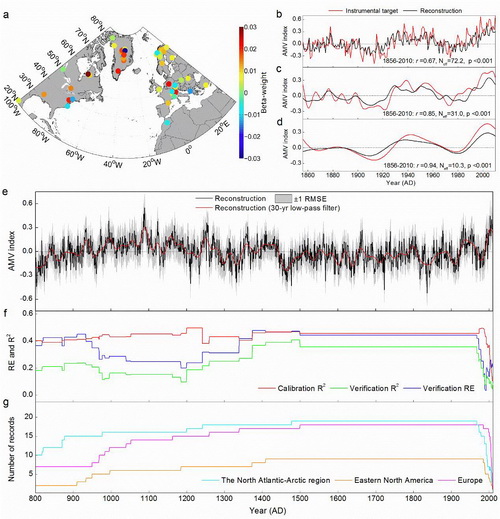A Large Contributor of Internal Variability to Atlantic Multidecadal Variability over the Past 1200 Years
Updatetime:2017-06-06From:
【Enlarge】【Reduce】
North Atlantic sea surface temperature exhibits pronounced variability on multidecadal timescales during the last 150 years, a behavior that is commonly referred to as the Atlantic multidecadal variability (AMV). The impacts of AMV are widespread, and include the modulations of Atlantic hurricane activity, African Sahel drought, Indian summer monsoon strength, and even the global surface temperature.
However, the origins of AMV remain unclear, in particular the extent to which it is driven by external (e.g., solar, volcanic and anthropogenic) forcings and internal dynamics of the climate system. Progress in understanding AMV has been limited by the relatively short observational record and further complicated by the projection of anthropogenic changes on this record over the past 150 years.
Recently, a research group of Prof. Yang Bao from the Key Laboratory of Desert and Desertification, Northwest Institute of Eco-Environment and Resources of the Chinese Academy of Sciences together with the coauthors from Sweden, Germany and United Kingdom address these questions by generating a 1200 year-length reconstruction of summer AMV using 46 annually-resolved climate proxy records. The results are now published in the journal Nature Geoscience.
The authors found that large volcanic eruptions and solar activities could explain about 30% of the variance in the reconstructed AMV on timescales greater than 30 years. The authors then isolated the internally generated component of AMV by removing an empirical estimate of externally-forced component from the reconstructed AMV. The results suggested that the internal variability (which they defined as the Atlantic multidecadal oscillation) is the largest contributor to Atlantic multidecadal variability over the past 1200 years. In addition, they identified coherence between the Atlantic multidecadal oscillation and Northern Hemisphere temperature variations, and concluded that the apparent link between AMV and regional to hemispheric climate does not arise solely from a common response to external drivers, and may instead reflect dynamic processes.
This new AMV reconstruction may contribute to facilitating a better understanding of the impacts of the AMV during the pre-industrial period on the climate in North America, Europe, Asia, as well as Greenland inland ice melt, Atlantic hurricane activity, and African Sahel drought. The better understanding of the relationships between the AMV and regional climates may have very important implications for decadal-scale climate predictions, because there may be more decadal predictability in the North Atlantic than in many other regions.
The lead authors (WANG Jianglin and YANG Bao) of this research are financially supported by the National Science Foundation of China (NSFC) (Grant No. 41325008, 41661144008, 41520104005 and 41602192) and the CAS “Light of West China” Program.
This research achievement has been published in Nature Geoscience with the title of Internal and external forcing of multidecadal Atlantic climate variability over the past 1,200 years.

Summer AMV reconstruction. a. Location of the 46 proxy records. b. Comparison between the reconstructed and instrumental AMV. c, d. As b, but 10-year (c) and 30-year (d) low-pass filtered. e. The AMV reconstruction for the past 1200 years (AD 800–2010). f. Reduction of error (RE) and explained variance (R2) for each nest. g. The number of contributing proxy records from the North Atlantic-Arctic region, Eastern North America and Europe for each nest. (Image by YANG Bao)
Contact
YANG Bao
E-mail: yangbao@lzb.ac.cn
Key Laboratory of Desert and Desertification, Northwest Institute of Eco-Environment and Resources, Chinese Academy of Sciences, 730000 Lanzhou, China.
Appendix




